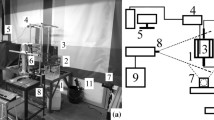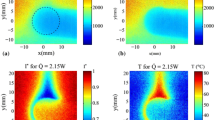Abstract
The liquid film is extensively used in various industrial production processes due to its excellent heat transfer efficiency, especially in the evaporating and cooling process, but little experimental data are acquired to represent the temperature field and heat transfer parameters with high spatiotemporal resolution. In this paper, planar laser-induced fluorescence (PLIF) technique was first described for the investigation of the temperature field of the liquid film in pipeline. An extraction method of fluorescence intensity based on the optimized average gray values, and a temperature field measurement method based on the two-dimensional planar laser intensity calibration were proposed, which effectively improved the temperature measurement accuracy of PLIF. The convective heat transfer coefficient of liquid film was calculated from the temperature field with high spatiotemporal resolution based on the heat transfer theory. In addition, the accuracy of PLIF temperature measurement was analyzed, and the relationships between the heat transfer coefficient and Reynolds number as well as heat transfer temperature difference were investigated experimentally.














Similar content being viewed by others
References
Seban RA (1978) Transport to falling films. Begel House Inc, Danbury
Yih SM (1986) Modeling heat and mass transport in falling liquid films. Handbook of Heat and Mass Transfer 2:111–210
Chun KR, Seban RA (1971) Heat transfer to evaporating liquid films. J Heat Transf 93(4):391–396. https://doi.org/10.1115/1.3449836
Alhusseini AA, Tuzla K, Chen JC (1998) Falling film evaporation of single component liquids. Int J Heat Mass Transf 41(12):1623–1632. https://doi.org/10.1016/S0017-9310(97)00308-6
Krupiczka R, Rotkegel A, Ziobrowski Z (2002) Heat transfer to evaporating liquid films within a vertical tube. Chem Eng Process Process Intensif 41(1):23–28. https://doi.org/10.1016/S0255-2701(00)00158-6
Prost JS, González MT, Urbicain MJ (2006) Determination and correlation of heat transfer coefficients in a falling film evaporator. J Food Eng 73(4):320–326. https://doi.org/10.1016/j.jfoodeng.2005.01.032
Naveed S, Hasan U, Ali AS (2011) Experimental investigation of heat transfer coefficient in vertical tube rising film evaporator. Mehr Univ Res J Eng Technol 30(4):539–548
Marquardt W (2005) Model-based experimental analysis of kinetic phenomena in multi-phase reactive systems. Chem Eng Res Des 83(6):561–573. https://doi.org/10.1205/cherd.05086
Pan R, Jeffries JB, Dreier T, et al (2014) Measurements of liquid film thickness and solute concentration of aqueous NaCl solution by absorption spectroscopy. Optics InfoBase Conference Papers, Imaging and Applied Optics - Propagation Through and Characterization of Distributed Volume Turbulence
Pan R, Jeffries JB, Dreier T et al (2015) Measurements of liquid film thickness, concentration and temperature of aqueous NaCl solution by NIR absorption spectroscopy. Appl Phys B 120(3):397–406. https://doi.org/10.1007/s00340-015-6149-2
Chinnov EA, Shatskii EN, Kabov OA (2012) Evolution of the temperature field at the three-dimensional wave front in a heated liquid film. High Temp 50(1):98–105. https://doi.org/10.1134/S0018151X12010038
Chauris N, Ayel V, Bertin Y et al (2015) Evaporation of a liquid film deposited on a capillary heated tube: experimental analysis by infrared thermography of its thermal footprint. Int J Heat Mass Transf 86:492–507. https://doi.org/10.1016/j.ijheatmasstransfer.2015.03.013
Schagen A, Modigell M, Dietze G et al (2006) Simultaneous measurement of local film thickness and temperature distribution in wavy liquid films using a luminescence technique. Int J Heat Mass Transf 49(25–26):5049–5061. https://doi.org/10.1016/j.ijheatmasstransfer.2006.06.010
Schagen A, Modigell M (2007) Local film thickness and temperature distribution measurement in wavy liquid films with a laser-induced luminescence technique. Exp Fluids 43(2–3):209–221. https://doi.org/10.1007/s00348-007-0289-z
Hsieh SS, Chen GW, Yeh YF (2015) Optical flow and thermal measurements for spray cooling. Int J Heat Mass Transf 87:248–253. https://doi.org/10.1016/j.ijheatmasstransfer.2015.04.005
Nakajima T, Utsunomiya M, Ikeda Y (1991) Simultaneous measurement of velocity and temperature of water using LDV and fluorescence technique. International Symposium on Applications of Laser Techniques to Fluid Mechanics
Sakakibara J, Hishida K, Maeda M (1993) Measurements of thermally stratified pipe flow using image-processing techniques. Exp Fluids 16(2):82–96. https://doi.org/10.1007/BF00944910
Sakakibara J, Adrian RJ (1999) Whole field measurement of temperature in water using two-color laser induced fluorescence. Exp Fluids 26(1–2):7–15. https://doi.org/10.1007/s003480050260
Hishida K, Sakakibara J (2000) Combined planar laser-induced fluorescence–particle image velocimetry technique for velocity and temperature fields. Exp Fluids 29(1):S129–S140. https://doi.org/10.1007/s003480070015
Lavieille P, Lemoine F, Lavergne G et al (2001) Evaporating and combusting droplet temperature measurements using two-color laser-induced fluorescence. Exp Fluids 31(1):45–55. https://doi.org/10.1007/s003480000257
Lavieille P, Lemoine F, Lebouché M (2002) Investigation on temperature of evaporating droplets in linear stream using two-color laser-induced fluorescence. Combust Sci Technol 174(4):117–142. https://doi.org/10.1080/00102200290020741
Thurber MC, Hanson RK (2001) Simultaneous imaging of temperature and mole fraction using acetone planar laser-induced fluorescence. Exp Fluids 30(1):93–101. https://doi.org/10.1007/s003480000142
Crimaldi JP (2008) Planar laser induced fluorescence in aqueous flows. Exp Fluids 44(6):851–863. https://doi.org/10.1007/s00348-008-0496-2
Schubring D, Ashwood AC, Shedd TA et al (2010) Planar laser-induced fluorescence (PLIF) measurements of liquid film thickness in annular flow. Part I: methods and data. Int J Multiphase Flow 36(10):815–824. https://doi.org/10.1016/j.ijmultiphaseflow.2010.05.007
Charogiannis A, An JS, Markides CN (2015) A simultaneous planar laser-induced fluorescence, particle image velocimetry and particle tracking velocimetry technique for the investigation of thin liquid-film flows. Exp Thermal Fluid Sci 68(5 Pt 2):516–536. https://doi.org/10.1016/j.expthermflusci.2015.06.008
Coolen MCJ, Kieft RN, Rindt CCM et al (1999) Application of 2-D LIF temperature measurements in water using a Nd : YAG laser. Exp Fluids 27(5):420–426. https://doi.org/10.1007/s003480050367
Seuntiëns HJ, Kieft RN, Rindt CCM et al (2001) 2D temperature measurements in the wake of a heated cylinder using LIF. Exp Fluids 31(5):588–595. https://doi.org/10.1007/s003480100338
Xue T, Lin X, Yang L (2016) Measurement of circumferential liquid film based on LIF and virtual stereo vision sensor. J Sens 2016:1–5. https://doi.org/10.1155/2016/2872947
Zhang F, Tang DL, Geng J et al (2008) Study on the temperature distribution of heated falling liquid films. Physica D 237(7):867–872. https://doi.org/10.1016/j.physd.2007.10.018
Acknowledgments
This work was supported by the National Natural Science Foundation of China [61671321, 61372143, 51475328 and 61828106], and the Natural Science Foundation of Tianjin in China [17JCYBJC18400].
Author information
Authors and Affiliations
Corresponding author
Ethics declarations
Conflict of interest
On behalf of all authors, the corresponding author states that there is no conflict of interest.
Additional information
Publisher’s Note
Springer Nature remains neutral with regard to jurisdictional claims in published maps and institutional affiliations.
Highlights
• Planar laser-induced fluorescence (PLIF) technique is first described for the investigation of the heat transfer performance of the falling liquid film in the pipeline.
• The optimized average gray values extraction method is proposed for calibration of temperature-fluorescence intensity with better accuracy.
• The laser intensity calibration method is proposed to acquire the temperature field of falling liquid film.
• The heat transfer coefficient is calculated and analyzed based on PLIF under different temperature difference and Reynolds number.
Rights and permissions
About this article
Cite this article
Xue, T., Zhang, S. & Wu, B. Study of spatiotemporally resolved temperature field and heat transfer in liquid film using PLIF. Heat Mass Transfer 55, 845–854 (2019). https://doi.org/10.1007/s00231-018-2465-5
Received:
Accepted:
Published:
Issue Date:
DOI: https://doi.org/10.1007/s00231-018-2465-5




